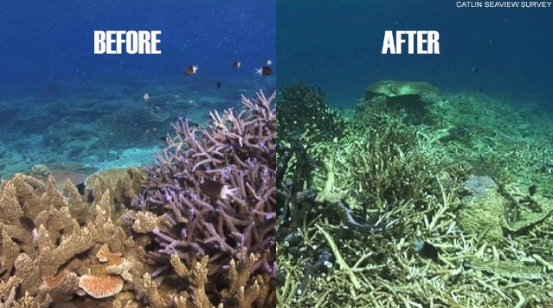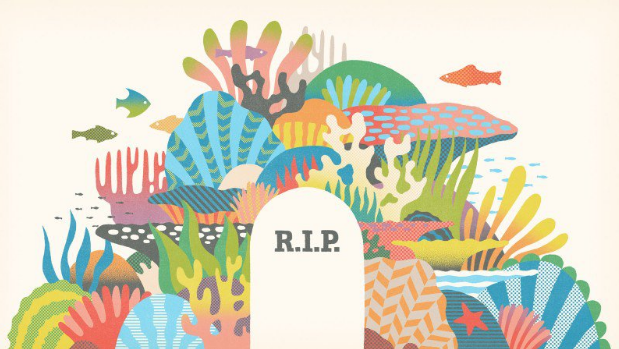The Decline of the Great Barrier Reef
October 27, 2016
Australia’s Great Barrier Reef, one of the world’s most beautiful natural treasures, was recently pronounced dead by several news outlets. An outrageous headline from Outside Magazine read “Obituary: Great Barrier Reef (25 Million BC-2016)”. This article garnered international attention with over 1.3 million reads. The plight of the Great Barrier Reef went viral on social media platforms such as Twitter, Facebook, and Instagram, sparking anger in many at the destruction that humankind has caused. But is the Great Barrier Reef really dead, or is this just an exaggeration?
The Great Barrier Reef is made up of 450 species of coral. This complex structure has become a haven for thousands of types of fish, birds, and mollusks for millions of years. It is 1,400 miles long, large enough to be seen from space. The UN named the reef a World Heritage Site in 1981, and CNN labeled it one of the seven natural wonders of the world. People have been enthralled by it since the early years of our species; aboriginal tribes in Australia have been hunting along the coast of the reef for millennia. Today, the Great Barrier Reef has over two million visitors per year.
The environmental catastrophe of the Great Barrier Reef is largely caused by coral bleaching, which has been observed at an extreme level since 1982. When water temperatures rise to a level that prevent coral from feeding on algae, it causes them to starve, lose their vibrant colors, and eventually die. Coral bleaching is largely believed to be caused by global warming. According to Ocean Scientists for Informed Policy (OSIP), 90% of the excess heat from our carbon emissions has been trapped in the oceans since 1955. This leads to an extreme weather phenomenon called El Niño, during which water temperatures in oceans worldwide rise much higher than normal. From 1997 to 1998, the world was hit by an extreme El Niño, which was reported to have killed 16% of the world’s coral reefs. However, scientists believe that the damage done in 2016 will top the damage from the 1997-98 El Niño, and will have some of the worst effects on the world’s reefs in history. Collective bleaching events caused by high carbon emissions have killed 22% of the reefs in the Great Barrier Reef, and bleached 93% of the reefs.

Along with coral bleaching, pollution, increased industrialization, and overfishing have also contributed to the demise of the Great Barrier Reef. Pollution from farms causes nitrogen run-off, which promotes algal blooms and leads to explosions of starfish populations.This upsets the ecosystem by smothering coral and preventing them from being exposed to sunlight, leading to their deaths. Port expansion off the coast of Australia and onto the reef disrupts the delicate balance of its ecosystem, and overfishing is threatening species such as turtles, dolphins, and dugongs. These issues could be improved if there was an increased presence from the Australian government in the Great Barrier Reef’s many troubles.
The short answer: no, the Great Barrier Reef isn’t dead. However, it’s not thriving, like it once was, either. It’s dying. After the report of the so-called “death” of one of Earth’s most amazing living things went viral, numerous articles were published by other news outlets explaining that while the Great Barrier Reef is dying, it’s not dead yet. Scientists have even come out against these articles, saying they are spreading “myth[s]”. Russell Brainard, chief of the Coral Reef Ecosystem Program at NOAA’s Pacific Islands Fisheries Science Center, told the Huffington Post that the reef is “very far from an obituary”. Terry Hughes, director of the ARC Centre of Excellence for Coral Reef Studies, agrees with Brainard. Both scientists stress the importance of optimism when discussing the horrific problems that the Great Barrier Reef is facing, saying that natural structures like the Reef do have some “ability to be resilient and bounce back”. According to a study conducted by seven different scientists in 2012, it takes one to two decades for coral reefs to restore themselves to their pre-bleached state. Kim Cobb, a coral reef expert at Georgia Tech, told the Guardian that “there will be reefs in 2050, including portions of the Great Barrier Reef, I’m pretty confident of that. I’m put off by pieces that say we are doomed.”
Although this seems like a bleak outlook on the Great Barrier Reef, there are small signs of hope that portions of the reef could, in fact, survive. While weak and dead corals are most likely a lost cause, stronger corals could be able to spread over the weak ones and take over, restoring the reef back to its original state. Scientists even have hope that corals could migrate away from the equator. The main message that scientists are trying to send in order to combat this rapid spread of misinformation is that there is hope for the Great Barrier Reef. Cobb said “There is a lot we can do to minimize climate change and we need to get going on that.” This is a call to attention that the Great Barrier Reef needs in order to survive. Hopefully, the damage that humans have done can be somewhat reversed, and it will be around for another 25 million years.







